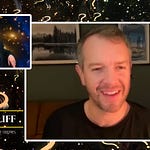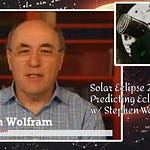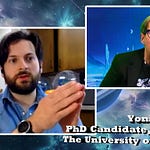This week on The Cosmic Companion, we’re talking about how It’s a Weird World, After All! Later in the show, we’re going to talk with Kathryn Williams about Weird but True! World 2024, new from National Geographic Kids!
Earth is a pretty bizarre place — let’s face it. Early on, our planet got whacked wicked HARD by a body the size of Mars. The debris left from this blow entered orbit around Earth, forming the Moon.
Beneath the crunchy surface of Earth, and under the nougat-like center of our planet’s mantle, lies a soft, chewy outer core, surrounding a solid, crunchy center, with each core made up (mostly) of iron, with a dash of nickel.
Kathryn Williams appears on The Cosmic Companion 9 September 2023. Creative Commons 4.0 Attribution 2023 The Cosmic Companion.
Vast quantities of heat are generated here, making the core of the Earth roughly as hot as the surface of the Sun! Part of this heat is left over from the formation of the planet, and some comes from friction. Perhaps half of this heat is the result of radioactive decay of heavy elements! Our planet is basically a nuclear fission reactor, putting out about 20 terawatts of heat, more than all energy usage by the human race.
Earth has the only known oceans of water found on the surface of a planet. And beneath the seafloor, we find roughly 300,000 trillion trillion microorganisms. THAT is a party!
Mosses are found all over the world, and they can absorb water directly from atmosphere, using structures called awns.
Fungi? Don’t get me started on fungus. Now there are your normal yeasts, molds, mildews, and mushrooms. The largest organism in the world is, in fact, a honey fungus living in the Blue Mountains of Oregon. Appropriately known as the 8,650, it is thought to be at LEAST 2,400 years old, and it might even be pushing its 8,650th birthday.
Fungi communicate amongst themselves and other species through chemical and electrical signals sent through underground networks of mycelia. Incredibly, these lifeforms can interpret signals they receive in context of other chemicals, the way words can change meaning based on the rest of a sentence.
Using old-fashioned human communication, we’re going to talk with Kathryn Williams about Weird but True! World 2024, new from National Geographic Kids!
So what ELSE is weird? Hmmm…
The fact that tardigrades (like Terrence the Terrifically Tremendous Tardigrade here) can live without food for decades, they can survive enormous blasts of radiation, and they’ve been known to live for long periods in the vacuum of space. That’s weird.
How do you do all that anyway?
*-#&
Really? Huh.
*+#&
I get it. Good Advice. Anyway, I’ll put you back down on your chair…
You know what else is weird? — the fact that Superman could put on a pair of glasses and pass himself off as Clark Kent, mild-mannered reporter.
Really? so, basically…
Clark Kent
Superman
Clark Kent
Superman
Clark Kent
SIGH — whatever.
And what is REALLY WEIRD is that I’ve been doing this show for almost 200 episodes now (including shorts), and I’m not rich and famous yet. I wonder what that would be like….
To be rich and famous…
Rich and famous…
Rich and famous…
Weird animals? Did I hear someone out there saying they want to hear more about weird animals?
Aye aye! Ooooh! Did I just say Aye Aye? Aye!
Aye ayes are the world’s largest nocturnal primate. They sport rodent-like teeth that never stop growing, and a distinctive spindly middle finger.
The axolotl, a critically endangered species of salamander from Mexico City, retains some of its larval features, including gills, right through adulthood.
How about the fact that flying lemurs don’t fly? Also, they’re not lemurs. Cute, though!
Speaking of flightless animals, the cassowary is known as a living dinosaur, and is considered the world’s most dangerous bird. You do NOT want to mess with one of these creatures. Did I mention that even if they can’t fly, they can jump up to two meters in the air? Yes. Yes. I’m pretty sure I did… [AAAAHHH!!!]
Dementor wasps inject a chemical potion into the heads of cockroaches, turning them into zombies who then willingly walk into the dementor wasp nest.
Coming in with, possibly, the most punk name in the animal kingdom is the Sarcastic Fringehead. When threatened, these Pacific fish are able to open their mouths twice as large as their heads at rest. If you think you’ve seen this creature before, you’re thinking of the Demogorgon from Stranger Things.
Have you ever wanted to study the brains of fish, but couldn’t bear the thought of hurting our helpless piscine friends? Let me introduce you to the Barreleye Fish living deep off the west coast of North America. Its head is transparent, giving the world a clear view of its brain.
Pretty weird.
Next week on The Cosmic Companion, we will welcome Neil deGrasse Tyson back to the show, talking about Artificial Intelligence and the Future of the Human Race.
Make sure to join us, starting on 16 September.
You know… if you subscribed to our show, or followed, or whatever you do on that favorite social media network of yours, you’d see every episode. Just sayin’. Or, head on over to our newsletter at TheCosmicCompanion.com and sign up. Do it. Do it!
Clear skies!
James
Follow us here on Substack, and make Terrence happy! (He also likes it when you share!)
























It's a Weird World, After All! with Kathryn Williams, Nat Geo Kids